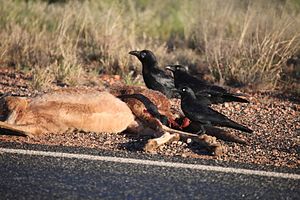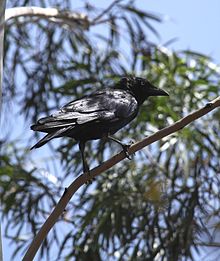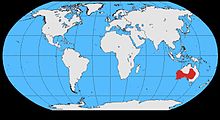Bennett Crow
| Bennett Crow | ||||||||||||
|---|---|---|---|---|---|---|---|---|---|---|---|---|

Bennett Crow |
||||||||||||
| Systematics | ||||||||||||
|
||||||||||||
| Scientific name | ||||||||||||
| Corvus Bennetti | ||||||||||||
| North , 1901 |
The Bennett's crow ( Corvus bennetti ) is a bird belonging to the genus of ravens and crows ( Corvus ). It occurs exclusively in Australia and some islands off the Australian coast. It is the smallest of the Corvus species found in Australia , which is only noticeable when compared directly.
Bennett crows utilize a wide range of food sources and are very adaptable in terms of their habitat requirements. The IUCN classifies its stock situation as safe ( least concern ). No subspecies are distinguished.
features
Build and color
Between the sexes of Bennett Crow is neither in the plumage coloration still in Build a dimorphism , the same applies to young and adult birds.
The Bennett crow reaches a body length of 44 to 48 cm. The beak is 48.8–54.7 mm long. It has a wing length of 292–341 mm, its tail measures 160–200 mm. The weight is between 330 and 485 g. It is thus significantly smaller than the New Holland crow , the most widespread Corvus species in Australia .
The plumage of the Bennett crow is uniformly black. The plumage on the head, neck, upper side of the body, breast, flanks and the plumage of the under tail-coverts shine black. The shimmer ranges from a metallic green on the ear covers to a blue-violet shimmer on the other parts of the body. The intensity of the shimmer strongly depends on the incidence of light. The underside of the body is matt black. Birds with worn plumage just before moulting can appear a bit browner overall. The feathers on the chin and throat are only slightly longer than the rest of the feathers.
The feathers all have a white feather base, the feathers are black only from the middle of the feather length. In living birds, this feather base is visible when strong winds blow the feathers apart.
The beak is black, the rear third of the upper beak including the nostrils is covered by bristle feathers. In adult birds, the iris is whitish with a light blue inner ring. The legs and feet are black.
Fledglings
Young birds are significantly smaller than the adult birds. Their beak is noticeably shorter. The plumage is not as shiny as in the adult birds and looks a bit brownish. The beak is already black in them, like in the adult birds, but the inside of the beak is pink. The iris is blue-gray.
Possible confusion
In Australia, come Corvus TYPES society Crow , Neuhollandkrähe , Tasmankrähe and Salvadorikrähe before that are difficult to distinguish in field observations of the Bennett crow. Three of the species, namely the crowded crow, the Tasmanian crow and the New Holland crow, have noticeably elongated feathers on their chin and throat, which is not so well developed in the Bennett's crow. The most reliable distinguishing feature between the individual species is reputation.
Distribution area and habitat
The distribution area of the Bennett's crow extends over most of the Australian continent. It is absent in the far north and in a wide strip along the Australian east coast. It is believed to be one of the species that benefited from European colonization of the Australian continent and the subsequent deforestation of forests in favor of agricultural land. Today it is more common, especially in western Australia.
The habitat of the Bennett crows are light, dry forest and bush areas. It occurs mainly in the Mallee with its low eucalyptus and acacia species, but is not limited to the type of vegetation.
food
The Bennett's crow is an opportunistic omnivore. However, it covers a large part of its nutritional needs with insects and other invertebrates. It also eats small vertebrates, including reptiles such as lizards and frogs, as well as smaller bird species as well as eggs and nestlings. Carrion also plays a role in their diet, although it is more often seen on fresh carcasses. It also eats fruits and grains. The food composition varies seasonally due to the different availability.
Trivia
The drip arborebird , which apart from the gray bowerbird found in tropical northern Australia is the only bowerbird with a distribution area in western Australia, mimics, among other things, the calls of the Bennett's crow.
literature
- PJ Higgins, JM Peter and SJ Cowling: Handbook of Australian, New Zealand & Antarctic Birds: Volume 7 Boatbill to Starlings, Part A: Boatbill to Larks . Oxford University Press, Melbourne 2006, ISBN 978-0-195-55884-5 .
Web links
- Videos, photos and sound recordings on Corvus bennetti in the Internet Bird Collection
Individual evidence
- ↑ a b Handbook of the Birds of the World on the Bennett Crow , accessed on May 16, 2017
- ^ Higgins, Peter & Cowling: Handbook of Australian, New Zealand & Antarctic Birds: Volume 7 Boatbill to Starlings, Part A: Boatbill to Larks . P. 755.
- ↑ a b c d Higgins, Peter & Cowling: Handbook of Australian, New Zealand & Antarctic Birds: Volume 7 Boatbill to Starlings, Part A: Boatbill to Larks . P. 745.
- ^ Higgins, Peter & Cowling: Handbook of Australian, New Zealand & Antarctic Birds: Volume 7 Boatbill to Starlings, Part A: Boatbill to Larks . P. 748.
- ↑ Clifford B. Frith, Dawn. W. Frith: The Bowerbirds - Ptilonorhynchidae . Oxford University Press, Oxford 2004, ISBN 0-19-854844-3 . P. 419

